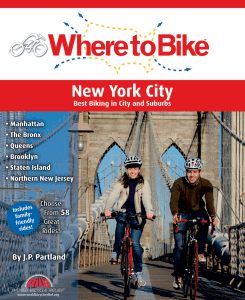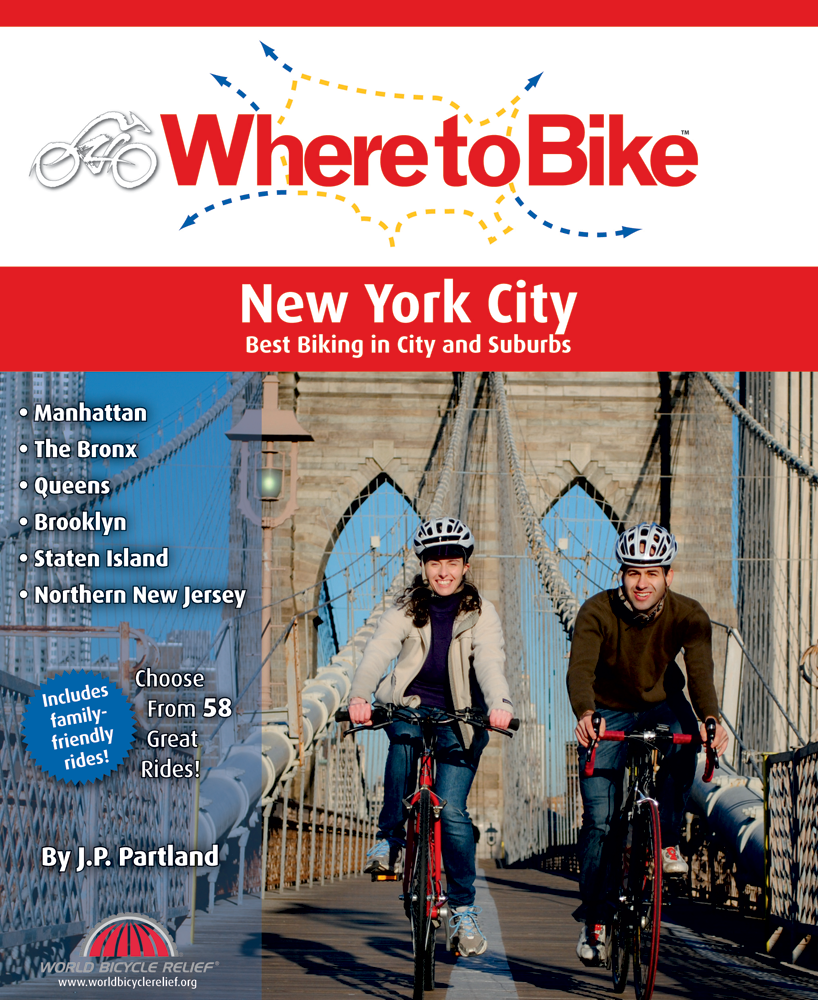The Book, that is. There is a way to use a book properly. And we detail how to use this book, because, you know, it’s even easier once you have a guide to the guide. The advice sets the table for the book. The book sets the table for more and better riding.
If you want to learn how to download rides, go here.
The book contains lots of detailed riding advice, like how to make sure your bike is safe to write, what to bring on the ride, how to comport yourself on and off the road, how to bring your bike on public transit, what the rules of riding are in both New Jersey and New York.

In Where to Bike NYC you will find 58 adult rides spread through five boroughs and just across the Hudson in New Jersey. We’ve broken down the rides into boroughs, with Jersey being effectively the sixth borough.
Within each section, the rides are identified as bike path, on-road, off-road or mountain bike, or any combination thereof. Most of the rides utilize bike paths; these are rides that are marked in some fashion and are separated from the road by anything from a painted line to a forest. This classification system is designed to make your initial selection quick and easy based on the terrain you’re likely to encounter along the way.
Ride Scale
To help you better understand at a glance how difficult each ride might be, this book rates the rides using the Where to Bike rating scale that the publisher, Bicycling Australia, used for all its cycling guidebooks. Each ride is assigned points based on the total distance covered, the elevation gain of the ride and the predominant road surface. Then the points are added up to determine the overall rating. The tables below show how these calculations are made.
You can find the Where to Bike rating on the introductory page of each ride; just look for the Bicycling Australia kangaroo symbols. The online rides just use “@” symbols: @-@@@@.
Scaling Expectations
The New York region has a wide variety of terrain and roads and wind. Some places, like Brooklyn, are pretty flat, but others are rather hilly. There is just about always wind coming off the water, so expect wind on any ride that runs along a river or bay or ocean.
The Where to Bike rating is only a guide. If you’re new to cycling or not currently fit, start with level 1 and 2 rides. As your cycling skills and fitness improve, you will be able to advance to the higher levels.
While the maps have been produced with accurate GPS-collected data, they do not always show sufficient information or detail to allow you to navigate relying exclusively on them. That’s where the ride logs opposite each map come in. Refer to the logs constantly as you ride, since they provide all the information and detail you’ll need to get from start to finish.
There’s also a chance that things have changed on particular roads and paths since I’ve been there last. Change in NYC can occur fast and places where there isn’t a bike path today, there might be one tomorrow. A bike path designated with sharrows (share-the-road arrows) today may be a protected path in a week.
And make sure you use the specifically designed inside front cover to keep you on the right page. This fold-out flap also includes the key to the maps and introductory pages.
We hope all of these design features will ensure that you enjoy rides that are safe and carefree, informative and entertaining.
Kids’ Rides
Riding with kids can be great fun. Problem is that in the more urban areas of the city, riding with them on roads that are shared with cars can be harrowing for the adults and potentially dangerous for the kids. Riding in parks also presents difficulties, because even if you have a park down the street, chances are it doesn’t have a road or path that’s permissible for adults to ride on. And as many New Yorkers don’t have cars, schlepping both an adult bike and a kid bike somewhere can be tough.
Riding bikes on sidewalks in New York City is only permissible when two criteria are met. The first is that the wheels must be less than 26 inches in diameter. The second is that the rider of the bicycle is 12 years of age or younger. Kids under the age of 14 are also required to wear a helmet.
My recommendation is that if you want to get your kids to ride more, first take them to a quiet park or empty basketball court where you can help them learn to balance on their own and observe them practicing until they get the hang of it. If it’s not crowded you can probably ride alongside them. Knowing how to start, stop, turn, ride a straight line, and signal are all essential skills. Then, take them to rides that are comprised entirely of off-street bike paths or just do the car-free segments of rides, like the Vanderbilt Motor Parkway in Queens, or Fort Wadsworth in Staten Island, or Bronx Park. Central Park, Prospect Park, the Marine Park Oval are obvious car-free selections (though the hills in Central and Prospect are tough for kids on single-speed bikes), but any waterfront bike path can be great as well, and there are those in every borough. There are waterfront bike paths in New Jersey as well, and both Liberty State Park and Lincoln Park are also easy for kids.
Kids are stronger than you think
I’ve been told that for kids under 10 years of age, riding up to 10 miles at a stretch is easily doable with a little training. I’ve personally experienced this; so long as you keep it fun and don’t talk up the challenge, 10 miles is pretty straightforward, if a bit slow. All the same, probably shooting for five miles or fewer is more easily attainable. Just getting them to ride is the first challenge. Once they can do that, four or five flattish miles shouldn’t be hard–and I’ve mapped many rides less than five miles in length.
Another interesting riding tip I heard was that the kid rides on the sidewalk while the parent rides parallel to them in the street. The parent accompanies them across the intersection. Then, if the road seems quiet, the kid rides on the street until the road seems to be getting busy with car traffic, then back on the sidewalk. Personally, I’ve found this advice difficult to heed; generally no one protests if you’re following your kid slowly on the sidewalk and being polite about it. If there’s a difficulty with sidewalks, it’s that kids don’t seem to typically speak up when someone is in front of them, which can spook adults and cause kids to crash. For that reason, the road can be easier. Oh, and the person who gets hit or scared by your kid will yell at you, and the kid will be upset by the crashing and the yelling.


